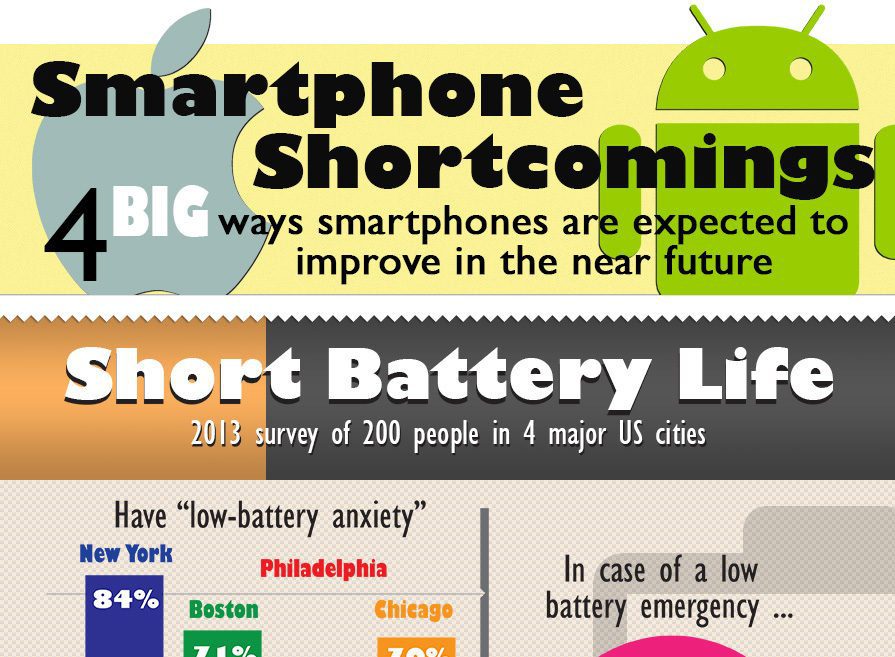Likewise, there are a number of mobile and computing technologies still in their early stages, available to some people but not all that widespread. We look at four things most people cannot do yet with their smartphone, tablet or computer, but which might be widely available to consumers in the next few years.
Use your mobile device or laptop all day without recharging. Quite possibly the biggest but least sexy problem with phones, tablets and laptops is battery life. Your device might last many hours on standby or sleep modes, but use it for anything for a short period, and it’ll need a recharge in a couple of hours or less.
Cell phones are now so much a part of many people’s lives that people actually get anxiety or even angry if their battery level drops. Here are some cell phone battery life statistics collected across four major U.S. cities (Boston, NYC, Philadelphia, Chicago) in 2013 by Veloxity.
- NYC mobile users charged their devices most often, at an average of 2.6 times per day. In Boston and Philadelphia, the average was 2.2 times per day, and 1.8 times per day for Chicago.
- 84% of New Yorkers surveyed had “low battery anxiety”. Other percentages: 71% in Boston, 70% in Chicago and 64% in Philadelphia.
- Of people surveyed, battery levels at
- 85% of people surveyed said they did not carry a backup mobile phone battery.
- 11% said they carried a spare charger.
- 4% said they carried an external battery.
Caveat: This survey’s sample size was only 200 people and may not represent cell phone battery level statistics and anxiety levels for most Americans.
Technology that solves the battery life problem exists and is already being tested:
- Berkeley Lab is testing one solution with graphene-based micro-supercapacitors that charge and discharge 3 times faster than the typical Lithium-based batteries.
- A more powerful super microbattery has been developed at the University of Illinois which is 3-dimensional in structure, could make devices 30 times smaller, are 2,000 times more powerful than competing technologies, and 1,000 times faster.
- Theoretically, a smartphone could be charged in less than a second.
- This micro battery could appear in consumer products in 1-2 years.
Access the Internet worldwide with or without cellular. An ubiquitous “mesh” network would create a seamless, wi-fi network around the world — at least on land masses — building upon existing “municipal wi-fi” in cities and towns, public wifi in airports, trains and other places, enhanced by cellular coverage where necessary. Internet-connected devices would seamlessly switch between cellular and mesh wi-fi access, without interrupting what you’re doing, allowing you to be always online. The components for a worldwide mesh network — especially municipal wi-fi — are already on every continent, but some places are more wireless than others, leaving coverage gaps.
- 1.1B people had smartphone subscriptions worldwide in 2012.
- 6.7B people had some form of mobile subscription in 2012.
- 5B people used 5.3B mobile handsets in 2012.
- 1.3B smartphones were in use worldwide at the end of 2012.
- 465M Android smartphones sold in 2012 — about 66% of the market.
- 31% of American Internet users had a tablet or e-reader device in 2012.
- 2.4 billion units of PCs, tablets and mobile phones, collectively, were expected to ship in 2013.
- 7 continents all have municipal wi-fi in at least one location.
- At the time of writing, Africa had a single municipal wi-fi installation in Luxor, Egypt.
- Asia had 31, as did Europe.
- North America had 96 in total, with 75 in the USA, 19 in Canada, and 2 in Mexico.
- Oceania had 5, as did South America.
![Smartphone Shortcomings [Infographic] 1 smartphone_shortcomings_900](https://eadn-wc03-10628962.nxedge.io/wp-content/uploads/2014/01/smartphone_shortcomings_900.jpg)




